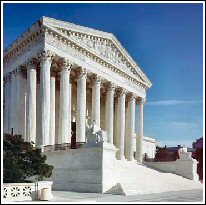FRtR > Outlines > The American Government > The Judicial Branch: Interpreting the Constitution > The Federal Court System
An Outline of American Government
The Judicial Branch: Interpreting the Constitution
The Federal Court System
*** Index * Next Chapter > ***
"... THE JUDICIARY IS THE SAFEGUARD OF OUR LIBERTY AND OF
OUR PROPERTY UNDER THE CONSTITUTION."
CHARLES EVANS HUGHES, Chief Justice of the U.S.
Supreme Court, 1930-1941
The third branch of the federal
government, the judiciary,
consists of a system of courts spread throughout the country,
headed by the Supreme Court of the United States.
A system of state courts existed before the Constitution was
drafted. There was considerable controversy among the delegates
to the Constitutional Convention as to whether a federal court
system was needed, and whether it should supplant the state
courts. As in other matters under debate, a compromise was
reached in which the state courts were continued while the
Constitution mandated a federal judiciary with limited power.
Article III of the Constitution states the basis for the federal
court system:
The judicial power of the United States shall be vested in
one Supreme Court, and such inferior courts as the Congress may
from time to time ordain and establish.
 With this guide, the first Congress divided the nation into
districts and created federal courts for each district. From
that beginning has evolved the present structure: the Supreme
Court, 11 courts of appeals, 91 district courts, and three courts
of special jurisdiction. Congress today retains the power to
create and abolish federal courts, as well as to determine the
number of judges in the federal judiciary system. It cannot,
however, abolish the Supreme Court.
With this guide, the first Congress divided the nation into
districts and created federal courts for each district. From
that beginning has evolved the present structure: the Supreme
Court, 11 courts of appeals, 91 district courts, and three courts
of special jurisdiction. Congress today retains the power to
create and abolish federal courts, as well as to determine the
number of judges in the federal judiciary system. It cannot,
however, abolish the Supreme Court.
The judicial power extends to cases arising under the
Constitution; laws and treaties of the United States; admiralty
and maritime cases; cases affecting ambassadors, ministers and
consuls of foreign countries in the United States; controversies
in which the U.S. government is a party; and controversies
between states (or their citizens) and foreign nations (or their
citizens or subjects). The 11th Amendment removed from federal
jurisdiction cases in which citizens of one state were the
plaintiffs and the government of another state was the defendant.
It did not disturb federal jurisdiction in cases in which a state
government is a plaintiff and a citizen of another state the
defendant.
The power of the federal courts extends both to civil actions for
damages and other redress, and to criminal cases arising under
federal law. Article III has resulted in a complex set of
relationships between state and federal courts. Ordinarily,
federal courts do not hear cases arising under the laws of
individual states. However, some cases over which federal courts
have jurisdiction may also be heard and decided by state courts.
Both court systems thus have exclusive jurisdiction in some areas
and concurrent jurisdiction in others.
The Constitution safeguards judicial independence by providing
that federal judges shall hold office "during good behavior" --
in practice, until they die, retire or resign, although a judge
who commits an offense while in office may be impeached in the
same way as the president or other officials of the federal
government. U.S. judges are appointed by the president and
confirmed by the Senate. Congress also determines the pay scale
of judges.
*** Index * Next Chapter > ***
 With this guide, the first Congress divided the nation into
districts and created federal courts for each district. From
that beginning has evolved the present structure: the Supreme
Court, 11 courts of appeals, 91 district courts, and three courts
of special jurisdiction. Congress today retains the power to
create and abolish federal courts, as well as to determine the
number of judges in the federal judiciary system. It cannot,
however, abolish the Supreme Court.
With this guide, the first Congress divided the nation into
districts and created federal courts for each district. From
that beginning has evolved the present structure: the Supreme
Court, 11 courts of appeals, 91 district courts, and three courts
of special jurisdiction. Congress today retains the power to
create and abolish federal courts, as well as to determine the
number of judges in the federal judiciary system. It cannot,
however, abolish the Supreme Court.